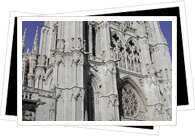Having managed to push the Moors towards the south of Spain, Christians across northern Spain suddenly found themselves with the freedom to worship as they pleased yet lacking religious buildings in which to do so. The Romanesque architectural trend began in northeastern Spain before spreading westward along the Way of Saint James pilgrimage route. You can find stellar examples of Romanesque architecture through Aragón, Castilla y León, Asturias and Galicia.
Spreading across northern Spain throughout the 10th and 11th centuries, Spanish Romanesque architecture began as a more or less rudimentary style. Romanesque architects really didn't have a model to follow for guidance, therefore the earliest Romanesque churches were constructed in the simple basilica form- essentially a three-naved box with a semicircular apse at one end. As Romanesque architects gained confidence and experience, the slightly more complicated Latin cross layout took over.
Typical characteristics of Romanesque architecture include thick stone walls, perfectly semicircular arches, barrel vaults, carved portals and little but predominantly geometric decoration (checkers, zig-zags, etc.). In addition, due to the insecurity of Romanesque architects about the best way to construct, doorways and windows are generally extremely narrow; interiors tend to be dim and solemn due to the lack of natural light.

Much like Romanesque architecture, Gothic architecture in Spain first spread westward across the north via the Way of Saint James. The Gothic trend first hit Spain's architectural scene in the 12th century, which served as a transition period that yielded many buildings boasting a mixture of the two styles. In the 13th century, Romanesque finally gave way to pure Gothic architecture- considered, along with Islamic architecture, to be one of Spain's two most dazzling trends.
With the successful Reconquest campaign, the outward growth of the Spanish empire and the accidental but lucrative discovery of the Americas, Gothic architecture coincided with a prosperous epoch of Spain's history- and it shows! Gothic architecture is all about spectacular size and jaw-dropping grandeur.
The thick walls and general bulk of the Romanesque period disappeared, replaced by open space, soaring heights and thin walls that seem practically skeletal compared to their predecessors. Flying buttresses were incorporated to support the new heights and thinner walls and large, beautifully crafted stained glass windows not only added color to the solemn interior but also allowed a great deal of natural light to pour in.
While decoration remained minimal, some typical decorative elements include clusters of thin columns, pointed cruciform arches instead of semicircular arches, lavish altarpieces and elaborate choir stalls. The end product - as you'll see in the Gothic architecture throughout Spain - is a stunning trend combining equal parts of sobriety and brilliance.